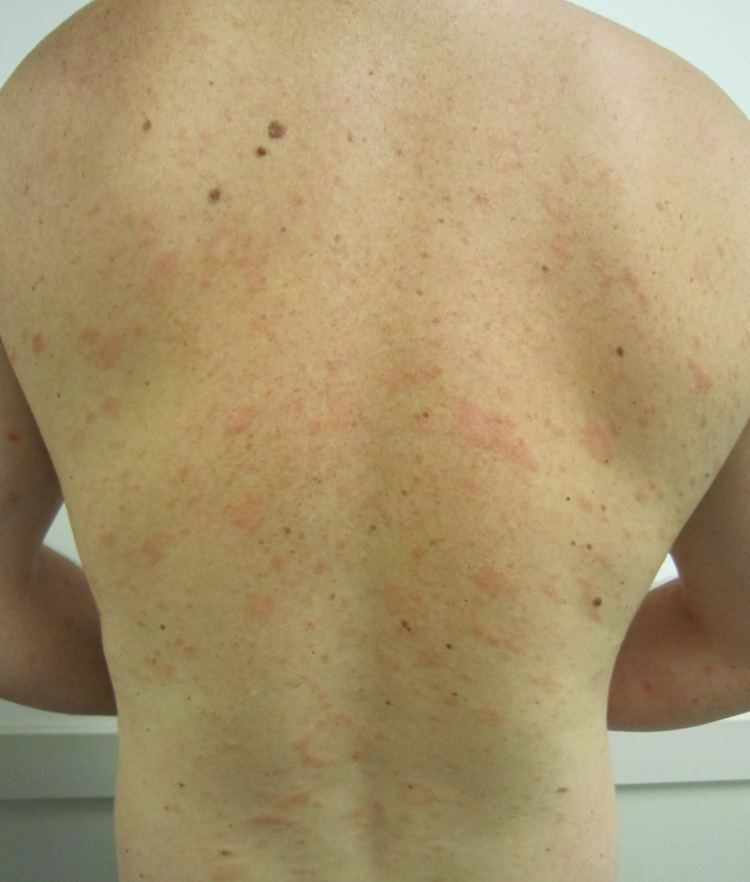ICD-10 L42 DiseasesDB 24698 | ICD-9-CM 696.3 MedlinePlus 000871 | |
 | ||
eMedicine derm/335 emerg/426 ped/1815 | ||
Pityriasis rosea (also known as pityriasis rosea Gibert) is a skin rash. It is benign but may inflict substantial discomfort in certain cases. Classically, it begins with a single "herald patch" lesion, followed in 1 or 2 weeks by a generalized body rash lasting up to 12 weeks, however usually around 6 - 8.
Contents
Signs and symptoms
The symptoms of this condition include:
Causes
The cause of pityriasis rosea is not certain, but its clinical presentation and immunologic reactions suggest a viral infection as a cause. Some believe it to be a reactivation of herpes viruses 6 and 7, which cause roseola in infants.
Diagnosis
Experienced practitioners may make the diagnosis clinically. If the diagnosis is in doubt, tests may be performed to rule out similar conditions such as Lyme disease, ringworm, guttate psoriasis, nummular or discoid eczema, drug eruptions, other viral exanthems. A biopsy of the lesions will show extravasated erythrocytes within dermal papillae and dyskeratotic cells within the dermis.
A set of validated diagnostic criteria for pityriasis rosea is as follows:
A patient is diagnosed as having pityriasis rosea if:
- On at least one occasion or clinical encounter, he / she has all the essential clinical features and at least one of the optional clinical features, and
- On all occasions or clinical encounters related to the rash, he / she does not have any of the exclusional clinical features.
The essential clinical features are the following:
- Discrete circular or oval lesions,
- Scaling on most lesions, and
- Peripheral collarette scaling with central clearance on at least two lesions.
The optional clinical features are the following:
- Truncal and proximal limb distribution, with less than 10% of lesions distal to mid-upper-arm and mid-thigh,
- Orientation of most lesions along skin cleavage lines, and
- A herald patch (not necessarily the largest) appearing at least two days before eruption of other lesions, from history of the patient or from clinical observation.
The exclusional clinical features are the following:
- Multiple small vesicles at the centre of two or more lesions,
- Two or more lesions on palmar or plantar skin surfaces, and
- Clinical or serological evidence of secondary syphilis.
Treatment
No treatment is usually required.
Oral antihistamines or topical steroids may be used to decrease itching. Steroids do provide relief from itching, and improve the appearance of the rash, but they also cause the new skin that forms (after the rash subsides) to take longer to match the surrounding skin color. While no scarring has been found to be associated with the rash, scratching should be avoided. It's possible that scratching can make itching worse and an itch-scratch cycle may develop with regular scratching (that is, you itch more because you scratch, so you scratch more because you itch, and so on). Irritants such as soaps with fragrances, hot water, wool, and synthetic fabrics should be avoided; a soap containing moisturizers (such as goat's milk) may be used, however, and any generic moisturizer can help to manage over-dryness. Calamine lotion may be soothing to the skin and reduce itching. Emulsifiers should be used instead of soaps, as emulsifiers are gentler on the skin and include cleansers, eliminating the need for soap.
Direct sunlight makes the lesions resolve more quickly. According to this principle, medical treatment with ultraviolet light has been used to hasten resolution, though studies disagree whether it decreases itching or not. UV therapy is most beneficial in the first week of the eruption.
Oral erythromycin was effective in treating patients.
Human Herpes Virus 6 or Human Herpes Virus 7 has been hypothesized to be the cause. The antiviral drug Acyclovir can reduce length of duration and severity.
Prognosis
In most patients, the condition lasts only a matter of weeks; in some cases it can last longer (up to six months). The disease resolves completely without long-term effects. Two percent of patients have recurrence.
Epidemiology
The overall prevalence of PR in the United States has been estimated to be 0.13% in men and 0.14% in women. It most commonly occurs between the ages of 10 and 35. It is more common in spring.
PR is not viewed as contagious, though there have been reports of small epidemics in fraternity houses and military bases, schools and gyms.
